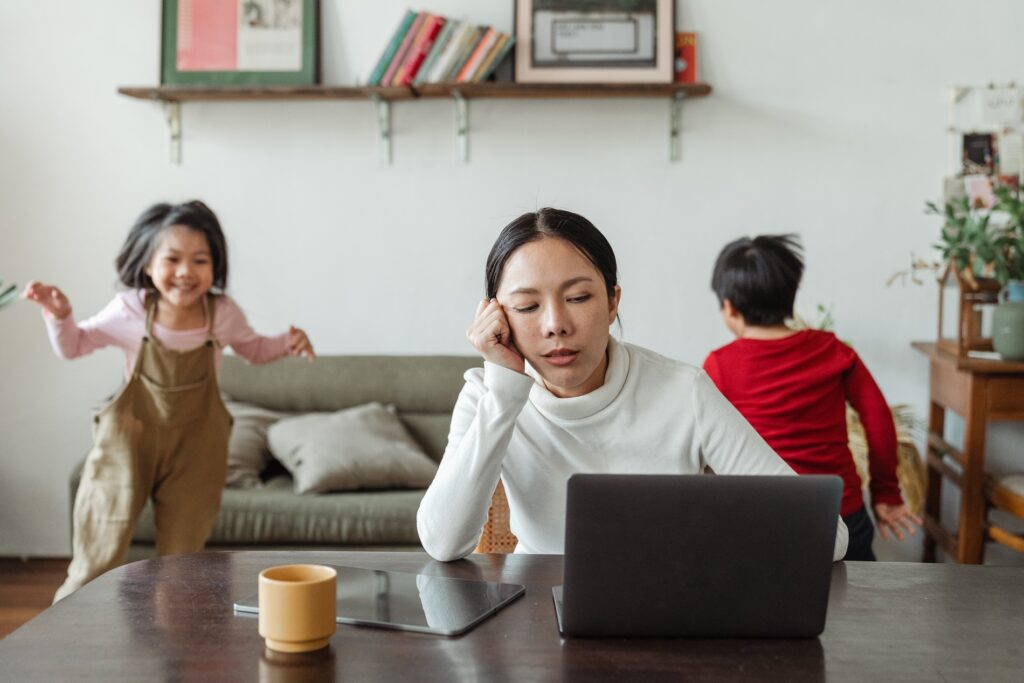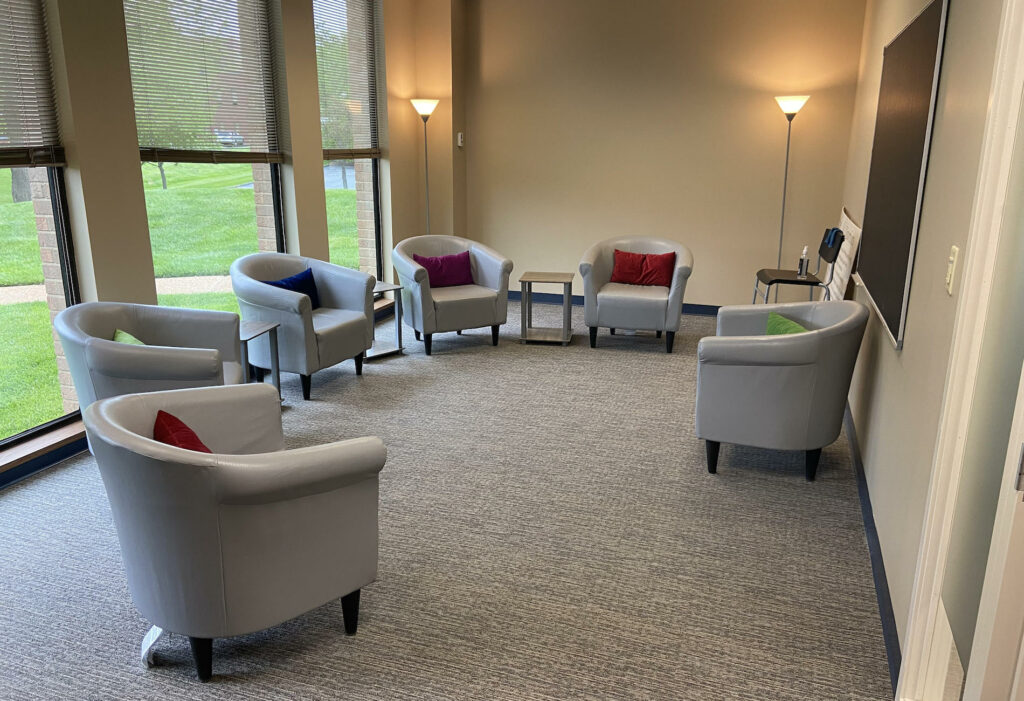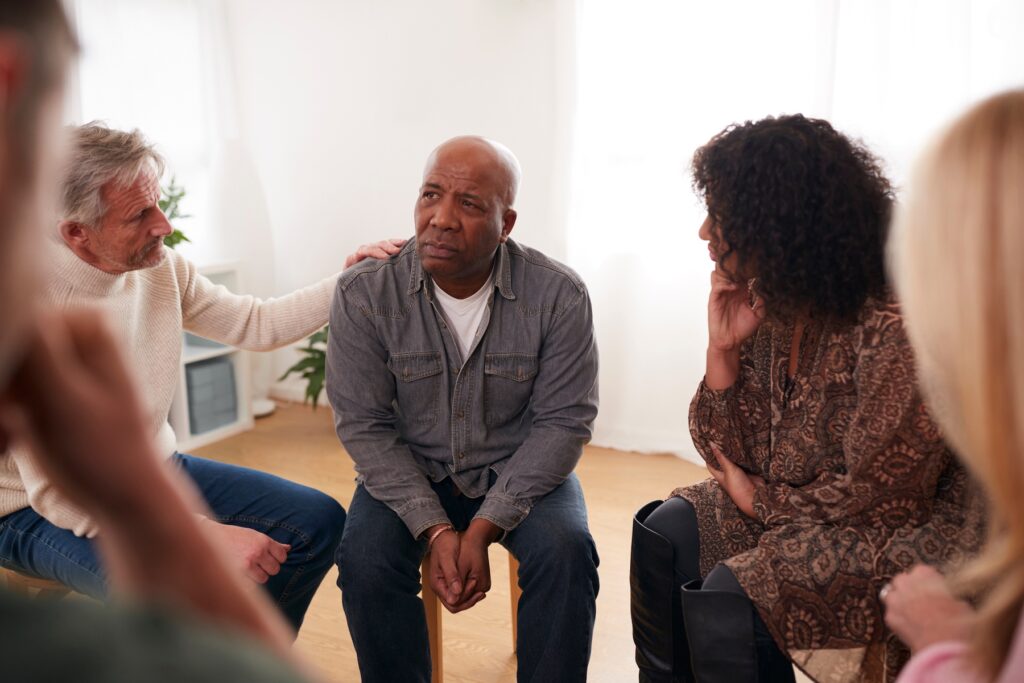If you’re nearing a breaking point with your mental health, you may consider joining an Intensive Outpatient Program (IOP). This level of care addresses serious mental health challenges. And it combines group therapy and personalized support to quickly improve your situation.
Normally, IOP happens in-person at a mental health center. But now, thanks to modern technology, you can also do IOP online – where you instead join group sessions from home using a video call.
But are these online IOPs effective? How do they compare to in-person ones? Which option should you choose?
At Plural Healthcare, we only provide IOP in-person. But in this post, we’ll walk you through the latest scientific research, share insights from our clinical experience, and help you better understand your options. No matter whether you (or a loved one) struggle with depression, anxiety, trauma, or other tough mental health problems, our goal is to help you find the right support.
Note: For lower levels of care like individual therapy, research shows telehealth options are often effective. However, IOP is different because it addresses more serious mental health challenges and uses a group therapy approach (rather than just providing care one-on-one).
Table of Contents
- Who Are We? And Why Should You Not Trust Us?
- What Is IOP In the First Place? And Who Can It Help?
- In-Person vs Virtual IOP – How Do They Compare?
- 3 Frustrating Issues With the Research About Virtual IOPs
- Scientific Research Suggests Virtual IOP Programs Have Potential
- Why Does Plural Healthcare Exclusively Use In-Person Programs for IOP?
- Our In-Person Programs Produce Exceptional Outcomes for Our Clients
- The Bottom Line… What IOP Option Should You Choose?
Who Are We? And Why Should You Not Trust Us?
We are Plural Healthcare. We offer intensive outpatient programs (IOP) to address serious mental health challenges and support holistic well-being.
- Our treatment team has decades of clinical experience helping people heal from PTSD, anxiety, depression, and other serious challenges. This includes developing, leading, and running multiple IOP programs starting from scratch.
- Our IOP is fully CARF accredited. CARF is an independent accreditor of mental health providers. And our program exceeds their high standards for quality.
- We’ve already helped people all across the St. Louis metro area (including LGBTQ individuals, school teachers, first responders, college students, and pro athletes).
We need to be upfront with you though…
We have a bias toward in-person programs. That’s what we offer. And from our clinical perspective, we believe attending group in-person creates the best outcomes for our clients compared to virtual programs (more about our reasons in a moment).
That said, what’s true for us may not be true for everyone. So we’ll do our best to share the advantages and disadvantages of both options (and examine the latest research). But you deserve to know our perspective from the start. That way you make an informed decision.
So…
What Is IOP In the First Place? And Who Can It Help?
IOP is a short-term intervention for those nearing a breaking point. It can help turn things around even when one-on-one visits with a therapist or psychiatrist aren’t enough. The goal with IOP is to create a noticeable improvement in a short period of time. (Most people see results from their first session and remain in the program for 6-10 weeks.)
- Group Therapy: Most of your treatment happens in a small group sessions. This allows you to learn and receive support from others – in addition to the therapist leading the group. Sessions provide a mix of practical education and emotional processing.
- Immersive Schedule: Programs usually have 3 sessions per week – each 3 hours in length. (There are also one-one-one sessions with a psychiatrist or therapist as needed.)
- Professionally Led: Sessions are led by a licensed therapist. They give you foundation mental health skills and help you work through the specific challenges you’re facing right now in your life.
Normally, the group therapy sessions happen on-location at a treatment center. But with the growing popularity of telehealth, more providers are experimenting with virtual-only IOP programs using video-conferencing tools like Zoom.
Is this a good thing though?
In-Person vs Virtual IOP – How Do They Compare?
In person programs and virtual programs both have a number of benefits and drawbacks. Below are some notable differences between the two formats:
In-person Intensive Outpatient Programs Pros/Cons
-
Advantages
- Direct Access to Support: If an issue comes up during treatment, clinical staff are able to intervene in real-time. Direct interaction allows for easier real-time adjustments to treatment.
- Stronger Groups: Group therapy is critical to the effectiveness of IOP programs. And face-to-face interaction enables greater emotional support and community building.
- Accountability: Physically attending a program can increase commitment and accountability. It’s also easier for the therapist to ensure everyone participates.
- Optimal Environment: A treatment center can be the ideal space for recovery and group conversations (e.g. providing a clean, beautiful, and distraction-free environment away from life’s stressors).
-
Disadvantages
- Accessibility: Not everyone has a quality IOP treatment center in their area. Those with physical disabilities may also find it challenging to attend in-person sessions.
- Logistical Challenges: The need to commute can make attendance difficult. This is especially true for those without reliable transportation.
- Stigma Around Treatment: Face-to-face treatment might deter some people due to perceived stigma around mental health issues.
Virtual Intensive Outpatient Programs Pros/Cons
-
Advantages
- Accessibility: If there are no IOP programs in your area, if you have physical limitations, or if you’re otherwise unable to travel to attend a group… then a virtual program may be your only option.
- Convenience: There is no need to deal with commuting to and from a mental health center for treatment. You can attend from almost anywhere.
- Familiar Space: Virtual programs allow you to participate from the comfort of your own home. This can be beneficial if you have a distraction-free home environment where you feel at ease.
- Flexibility: Online schedules can sometimes offer greater flexibility in accommodating personal or work commitments.
-
Disadvantages
- Technical Barriers and Distractions: The need for stable internet and technology skills can prevent some people from participating. Distractions such as noise, other people, or a messy space make some home environments less than ideal for focused, therapeutic work.
- Reduced Social Connection: The virtual setting may limit the depth of human interaction and non-verbal communication – especially between participants in the group. And it could also create feelings of detachment from the therapeutic process.
- Less Insurance Coverage: Fewer insurance plans cover virtual treatment programs. And you may have to pay for treatment out of pocket.

These are all useful factors to consider when comparing your options. However, the purpose of IOP is to help you create a noticeable transformation in your life. And the big questions you need to ask are…
Is virtual IOP a valid treatment option? Between in-person and telehealth IOP programs, which provides the most effective treatment? Which format will best address your unique challenges?
Several researchers have attempted to answer these questions. They’ve published formal studies to see if telehealth IOP programs can help treat anxiety, depression, and other mental health challenges.
Unfortunately, there are…
3 Frustrating Issues With the Research About Virtual IOPs
We’ve looked through dozens of studies evaluating telehealth IOPs. And there are some shortcomings. These include not enough good studies, a lack of direct comparison between virtual and in-person programs, and a failure to account for the quality of the program or provider. (Note: We hope more studies will address these issues in the future.)
Problem 1: There Aren’t Enough Studies Yet
Unlike individual therapy or psychiatry, IOP is not a well-known treatment option. At Plural Healthcare, we sometimes refer to IOP as the “hidden gem” of the mental health world. (It’s something many could benefit from at some point in their lives. But few people know IOP even exists.)
As a result, fewer researchers have studied virtual IOP programs compared to other forms of mental health care. At the time of writing, there are thousands of studies related to telehealth and mental health therapy. In contrast, there are roughly 40 studies related to telehealth intensive outpatient programs.
In addition:
- Many studies are directly funded and performed by IOP providers themselves. This research is still valuable. But we’d like to see studies done by independent, 3rd-party organizations as well.
- Only a small percentage of these studies examine mental health IOPs (e.g. programs that focus solely on mental health issues like anxiety and depression). Most research examines substance use or dual diagnosis IOPs.
- Almost all studies use results from a single provider… rather than collecting broad, diverse data that covers multiple IOP providers, treatment modalities, geographic areas, and program types.
All of this is understandable. Quality research requires lots of time and money. But the shortage of studies means you have to be careful about drawing firm conclusions.

Problem 2: Many Studies Compare Virtual IOPs Against No Treatment at All
Of the studies that do exist, many fail to make a direct comparison to in-person programs. They instead study the impact of virtual programs in isolation. This makes it hard to say whether virtual programs are better or not.
For example, a 2021 study looked at the effectiveness of virtual IOP programs for teens and young adults. (Note: This study was funded and performed by a provider of virtual IOP programs.) The researchers noted decreases in depression scores from intake to discharge. And they concluded:
“Findings support the use of remote intensive outpatient programming to treat depression among youth and young adults, suggesting that it may be a modality that is an effective alternative to place-based mental health treatment.”
It’s wonderful their telehealth programs are helping clients find relief. Unfortunately, the study itself was not evaluating virtual programs alongside “place-based mental health treatment”. It only looked at virtual programs. So the study can’t actually say if virtual is an equivalent option.
Problem 3: Studies Don’t Consider the Quality of the Program or Provider
Quality is tricky to measure objectively. So most studies instead compare virtual programs to in-person programs that are both run by a single provider or organization. That way they don’t have to account for program quality.
This is an understandable approach. Yet when it comes to mental health treatment, the choice of therapist, organization, and program matters a lot. In fact…
The quality of the provider is often the single biggest factor for the effectiveness of treatment.
Lots of good IOP providers exist. But you have to watch out for some not-so-good IOP providers too. And regardless of which format (virtual or in-person) is “best” for IOP, you’re much better off going through a quality program led by a skilled therapist over one that’s poorly run. (Not sure how to find a good mental health provider? There are 4 key criteria you should look for.)
Scientific Research Suggests Virtual IOP Programs Have Potential
With the above limitations in mind, what does the current research tell us? Of the studies that do exist on virtual IOP programs, what can we learn from them?
Scientific Research Summary: Virtual IOP Programs
- Virtual programs must be carefully designed to compensate for certain limitations. If you’re considering a virtual program, there are several important questions to ask.
- You’re better off seeking treatment with a virtual IOP program than doing nothing… especially if there are no other programs available in your area.
- A few studies found virtual programs may produce comparable outcomes to in-person programs.
Let’s look at each of these in more detail…
Virtual IOP Programs Must Be Designed to Overcome Certain Limitations
One study by Rush University Medical Center examined the challenges from shifting their intensive PTSD treatment program to fully virtual. This program was a higher level of treatment than IOP (~40hrs of active treatment per week instead of ~9hrs/week). But the in-depth discussion in the study is worth learning from.
Based on the challenges and obstacles the researchers discuss, there are…
8 Types of Questions to Ask Your Virtual IOP
- Program Structure: Could you explain how the online sessions differ from an in-person program? How have you adapted to program for a virtual format? Are there any elements you’re unable to replicate online, and how does that impact my treatment?
- Individual Connection: How will my therapist or counselor build a personal connection with me through the virtual sessions? What’s your approach to ensuring individual attention in an online group setting?
- Group Support: How do you cultivate a feeling of community despite being in an online setting? What kind of activities or strategies do you use to keep everyone engaged during online sessions? How do you ensure everyone is accountable and participates in the group?
- Technology Requirements: What kind of computer or device do I need? What kind of orientation or training will I receive to get comfortable with the online format? If I run into trouble, do you have someone available to help?
- Environment: What steps do you take to create a focused, distraction free environment for receiving care? How do you handle background noise coming through people’s microphones or situations where people lack private room to attend group from?
- Privacy: How do you ensure conversations in group sessions stay private? What steps do you take to secure the virtual meeting space and maintain confidentiality for each participant?
- Crisis Support: What happens if I have an urgent issue or crisis? Is there an emergency system in place for immediate help outside of session hours?
- Credentials and Insurance: Are your services licensed for my area? What insurance providers do you accept?
If you’re considering a virtual program, talk with the provider and ask how they’re addressing these challenges with telehealth treatment. You can tell a lot about the program based on whether they’ve thought about these questions before or not. (Note: Many of these questions also apply to traditional, in-person programs.)
Virtual IOP Likely Produce Positive Outcomes
Several studies show improvements among those who attended virtual only IOP programs. For example, a study by Rogers Behavioral Health System concluded, “For patients living far away from treatment centers or for patients who cannot leave home to attend in-person treatment, these results demonstrate telehealth treatment as a viable alternative to in-person treatment.”
And in another study, Mayo Clinic found clients with serious mental illness “reported satisfaction with the group-based IOP delivered via telehealth.”
This is encouraging news. Over 150 million Americans live in a federally designated “mental health professional shortage area” and struggle to get the help they need. So having the option of attending virtual IOP is valuable. It means some people will be able to get care who wouldn’t otherwise.

In Some Studies, Virtual IOP Generated Similar Results to In-Person IOP Programs
A few studies directly compare virtual and office-based programs. For example, therapists at Western Psychiatric Hospital in Pittsburg were forced to transition their in-office IOP to a virtual only program at the beginning of the COVID-19 pandemic. And they compared clinical outcomes between both groups of clients using the PHQ9 and GAD7 scales (common measures for depression and anxiety levels).
The study authors concluded: “Despite some limitations, telehealth IOP appears to be a clinically appropriate option. […] Improvements in PHQ-9/GAD-7 scores and measures of participation were not significantly different between telehealth and office-based IOP.”
Besides mental health IOPs, a few studies have also examined substance use and eating disorder programs. They suggest remote IOPs may produce similar results to traditional IOPs.
These are promising early results. But you may be wondering… if studies say virtual programs are a potentially valid treatment option, why don’t we offer them at Plural Healthcare?
Why Does Plural Healthcare Exclusively Use In-Person Programs for IOP?
Our treatment team has looked at the available data on virtual programs. We’ve consulted with other experts in the industry. We’ve drawn from decades of experience leading IOP groups (seeing first-hand what works and what doesn’t). And our staff have personally tested virtual programs. After all that, we’ve concluded:
In-person programs are the best choice for us and for the people we serve.
See, we’re obsessed with creating the best outcomes possible for our clients. We don’t want to only see marginal improvements to depression and anxiety scores (although that’s great too). We want to have a dramatic, positive impact on our clients’ lives. We want to empower people, support their healing, and help create a noticeable transformation in their situation.
To create these results, we believe in-person IOP is better due to four primary reasons.
Reason 1: We Are Not Yet Convinced by the Research Supporting Virtual IOPs
Initial research on virtual IOPs is promising, but it’s not conclusive enough yet. We would especially like to see larger studies that combine data from multiple IOP providers (including a diverse range of geographic areas, treatment approaches, and program types).
One could argue we’re being overly critical of the research. That’s a fair criticism. However, we have direct clinical experience proving the effectiveness of in-person programs. And it’s our responsibility to provide the best care we can to our clients. That means we expect a higher level of proof to show virtual programs really do work.
This skepticism of virtual IOPs is not unique to us either. We’ve heard similar perspectives from partners and other mental health professionals.
One large therapy group in St. Louis told us they like referring clients to our IOP because our program is not virtual. And many insurance companies won’t cover virtual programs either. (In fact, one leading insurance provider announced they will eliminate coverage for telehealth IOP in 2024.)
Reason 2: In-Person IOP Provides a Better Environment for Treatment
Some virtual providers highlight that you can get treatment “in the comfort of your own home”. However, when it comes to IOP, that’s not necessarily a benefit:
- Many people don’t have a distraction-free, quiet, and private space to attend groups from. (And even if you do, background noise from other participants can be distracting and make it hard to focus.)
- Home can be a highly charged or stressful place for some people. In fact, many participants join IOP because of issues at home or with their family members.
- Attending a conference call from your computer or tablet adds its own set of distractions. (Some find it tempting to browse the internet rather than participating in group.)
In contrast, attending group at an IOP center can make it easier to focus. It helps shift you into the right frame of mind for healing.

It’s kind of like going to a gym. A gym has equipment and staff to help you meet your goals. And when you step into the gym, you know you’re there to get stronger and healthier. And so that’s what you focus on.
Likewise, when you arrive in the group room for in-person IOP, you’re entering a peaceful space where you can start healing and learn new skills. And just like a good gym, you’ll have peers and staff there to help support you in your journey.
Reason 3: In-Person IOP Enables Stronger Group Connections
Modern communication tools are great. They help us connect and keep in touch with loved ones even when they’re far away. And yet, many of us still fly half-way across the country to see family each Christmas. There’s just something special about being together in real life.
The same is true with IOP. You benefit from being in the same room as everyone else. This matters a lot because the group dynamic is so important for IOP. (Yes, the therapist has an important role. They’re there to share new skills, offer support, and guide the conversation. But the real power of IOP is the group.)

In group, you’ll gain support and community. You’ll discover you’re not weird… and that others face similar challenges as you. You’ll find a safe, welcoming space to process and work through whatever you’re going through. You’ll benefit from other people’s perspectives and insights.
Attending in IOP in-person lets you connect with other group members on a deeper level than if you were talking through a computer screen. And the more you connect with others in the group… the more you discover, grow, and heal.
Reason 4: Our Treatment Staff Tested Virtual Programs and Found Them Inferior
Like many providers at the start of the pandemic, our therapists had no choice but to temporarily offer IOP in a virtual format. This was better than simply stopping our program altogether. But we found that going virtual reduced the quality of treatment and satisfaction of clients. When we ran a telehealth IOP group…
- Background noise often disrupted the sessions and made it harder for other participants to pay attention.
- Some clients kept turning off their camera and disengaging from the group session. This made it harder for our treatment team to provide care. But also, insurance companies require video to be on for the entire session to count for attendance.
- Several members struggled using the video tools on their computers. (If we were to do virtual IOP again, we would create special trainings and have dedicated support on hand to help those not comfortable with teleconferencing technology.)
- Compared to in-person programs, we found members were more likely to sit back and passively listen during the sessions with virtual. (The best results with IOP come when people engage and participate in the discussion.)
- While clients did often engage directly with the therapist, our staff found there was less interaction and dialog between group members.
Some of these challenges could be addressed and likely minimized. But in our view, the downsides (especially around the group dynamic) are still too significant.
Will we ever try virtual IOP programs again in the future? It’s not in our plans. If we someday see a way to still create exceptional outcomes in an online format, we may consider it at that point. But for now, we’re strong believers in the power of in-person programs. We know they work.
Our In-Person Programs Produce Exceptional Outcomes for Our Clients
We measure the effectiveness of our programs. And we use a wide range of data to ensure our IOP helps each client as much as possible:
- We use industry-recognized assessments such as the GAD-7 and PHQ-9 at intake, discharge, and weekly over the course treatment. On average, committed clients see a 38% drop in anxiety symptoms and a 43% decline in depression symptoms.
- We have every client fill out an anonymous satisfaction survey at discharge, which covers aspects of our service like…
| Survey Item | Rating |
|---|---|
| My overall satisfaction with services at Plural Healthcare | 4.8 |
| Therapist was respectful of my pace and readiness. | 4.9 |
| I was involved in developing my treatment goals. | 4.8 |
| I was able to experience significant improvements in my mood, outlook, ability to cope with life, and ability to set goals for what I want for the future. | 4.7 |
| I was able to meet goals I set for treatment, and feel greater personal satisfaction. | 4.5 |
| The likelihood of my recommending this program to others. | 4.9 |
- At discharge, we ask clients to evaluate how 22 different areas of their life changed over the course of the program. 100% of clients report improvement with personal relationships, trauma, and ability to manage emotions. 85% of clients say they now have greater self-esteem and improved mental patterns.
Note: These metrics are averages based on 2022/2023 clinical data. Not everyone will experience the same results, but this at least shows what’s possible.
But not only do we see signs of transformation show up in the raw numbers, our clients also share about their experience in their own words…
“Plural Healthcare absolutely saved my life. The staff are incredibly knowledgeable, empathetic, and resolution-based. I cannot recommend this facility highly enough for mental healthcare. They’re the reason I’m still here today and got my life back.”
– C.K.
“Group at Plural Healthcare has been an extraordinary experience! I believe every aspect and discussion has helped me learn more about myself, the reasons for the difficulties I was dealing with, and how to come up with solutions and coping skills to help me now and in the future.”
– R.L.
“The staff at Plural Healthcare are genuinely focused on client healing. They have excellent therapists and were an integral part of my healing. I’m so thankful!”
– J.C.
The Bottom Line… What IOP Option Should You Choose?
We advocate for in-person IOP at Plural Healthcare. Yet as much as we believe in our programs… we can’t give you a simple answer here. There are no one-sized-fits-all approaches to mental health care. What’s best for you depends entirely on your unique situation, current challenges, and personal preferences.
That said, we can offer some guidance:
- Determine if IOP right for your situation in the first place. Intensive outpatient care can be life-changing. But it may not be for you. Depending on your needs, you may need a lower or even higher level of care. If you’re not 100% sure, give us a call. We’ll discuss your situation and see if our program is a fit.
- See if you even have the option to choose between a virtual or in-person program. We wish everyone had easy access to a local IOP. But you may live in a remote area with few mental health providers nearby. Also check with your insurance. Because insurance companies do not always cover treatment with telehealth IOPs. (If insurance doesn’t cover your treatment, some providers offer a self-pay option.)
- We recommend you attend IOP in-person if possible. For the reasons noted above, we believe in-person IOP creates a more powerful group experience and leads to better results. But you’ll need to decide for yourself what’s right for you.
- Focus on the quality of the provider. This is way more important than deciding between virtual or in-person. You want to an organization that (1) can show strong client testimonials and measurable outcomes, (2) has a qualified clinical staff, (3) is up-front about its pricing, and (4) is ideally accredited by an independent 3rd-party.
- Ask lots of questions. What’s the the program like? How is it structured? Do they provide individualized care (even in a group setting)? What are their expectations from you during treatment? Is the program right for someone in your situation? And so on. Not only will a good provider answer any questions you may have… they will be excited by your curiosity and engagement.
If you’re at all interested in IOP and how it may help you (or a loved one)… please reach out today. We’re here to help however we can. If that means you attend our IOP, we’ll be delighted to serve you. If not, that’s fine too. IOP isn’t for everyone. And we’re more than happy to refer you to other trusted providers that may be a better fit. Either way, we hope you find the support you need.
